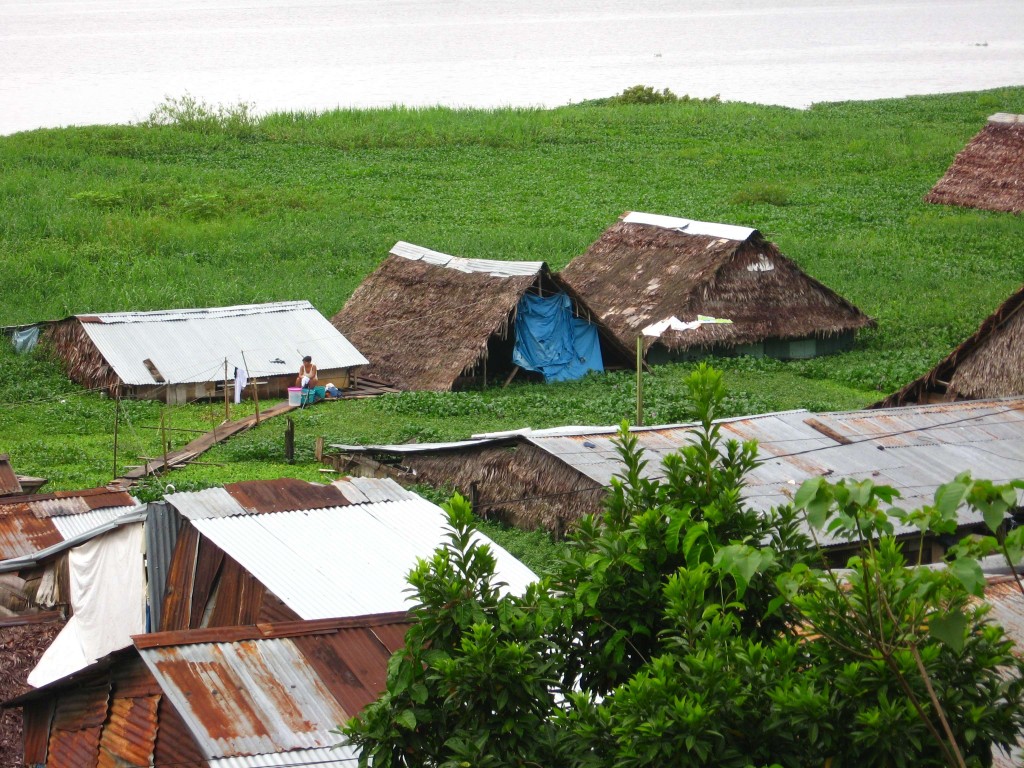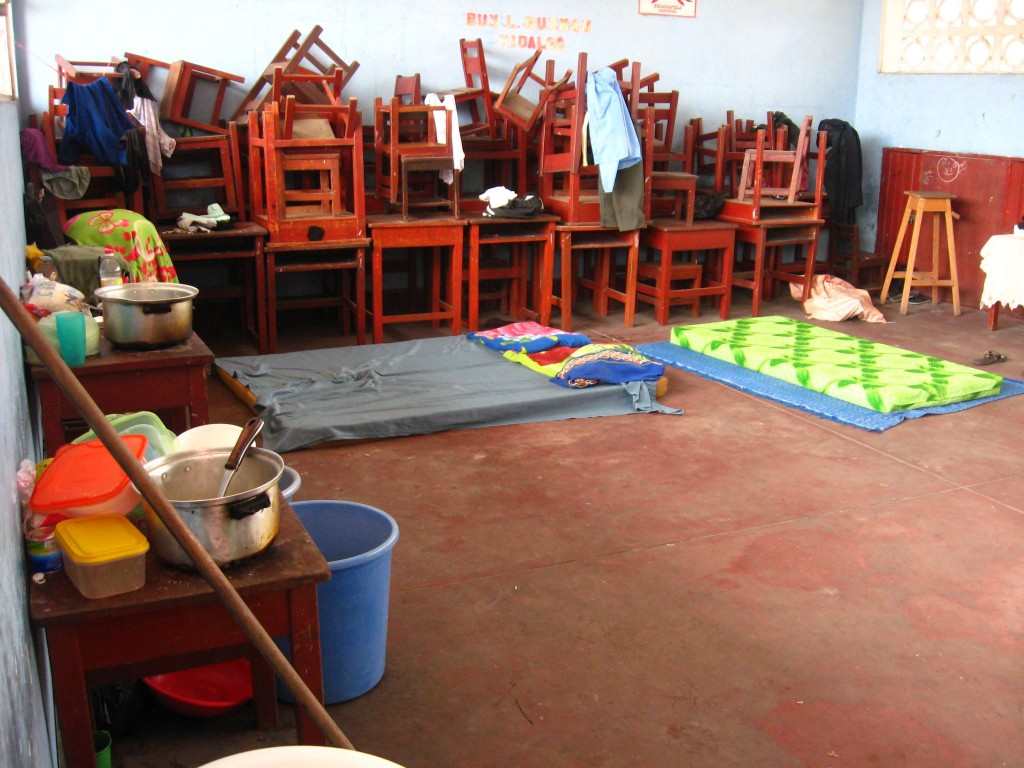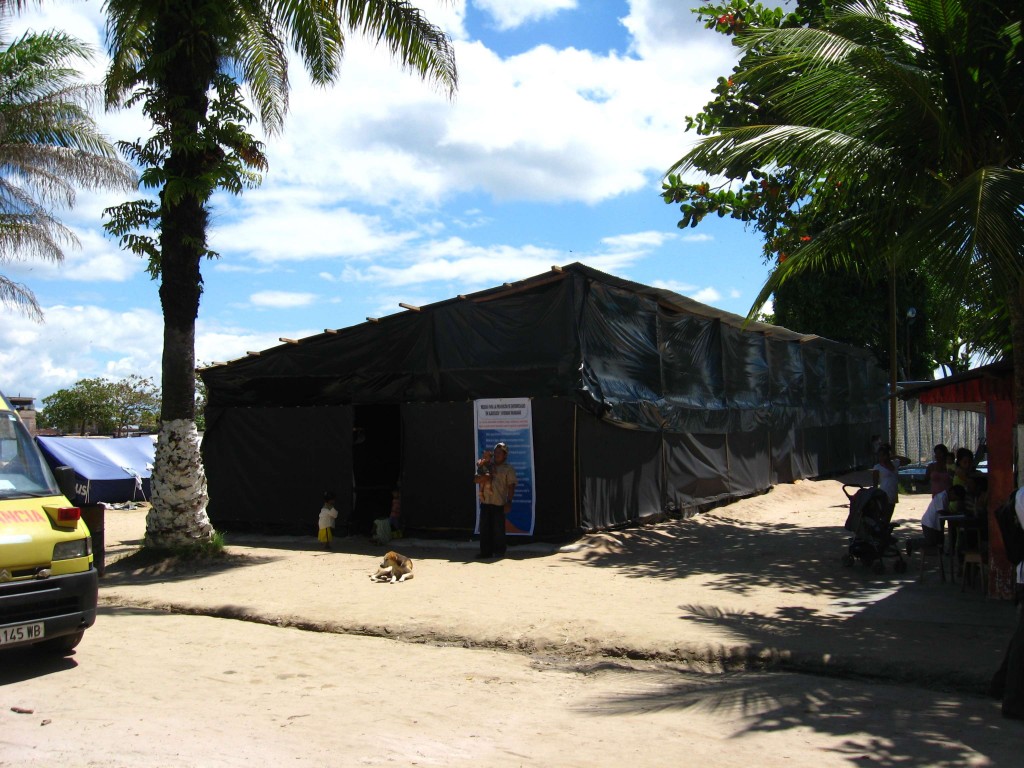The recent floods that ravaged the Amazon regions of Peru as well as the city of Iquitos, and reached and surpassed the highest point [es] recorded in history since 1986 (see illustrative photos of the reported floods taken by a member of the Red Cross), began to subside at the end of April [es] and started visibly draining away in the first days of May.
Rodrigo Rodrich, correspondent residing in Iquitos commented [es] in the middle of this month:
Al día de hoy los ríos llevan un par de semanas en descenso sostenido, pero aun por encima de sus límites de desborde. Son síntomas de esperanza. Sin embargo, hay poblaciones que fueron inundadas durante tres meses y se dice que lo peor es lo que ahora viene, cuando el agua se retire y deje evidente el desastre.

Flooded zone in Belén, Iquitos. As the floods rose, the villagers built paths with wood boards to move around. Photo by Juan Arellano.
The consequences left by this natural phenomenon, beyond the number of the victims, which is estimated to be about 200,000 people [es], should raise concern due to the lack of foresight [es] and disaster management plans [es] on part of the authorities of the regions. Once the waters began to recede, the victims returned to their homes in the flooded zones and the scenery is prime for the next possible flood.
One of the more controversial measures taken to quell the disaster was the suspension of classes for various primary schools in the city of Iquitos to serve as temporary shelters [es] for the victims. This, plus the classes suspended in schools affected by floods, affected the school year, and although classes have resumed [es] progressively in schools, it has been said that there will be no vacation time in the month of July and that classes would be extended until December 28.
Among the things most feared during the period of flooding, and even now, was the quick spread of diseases, starting with dengue fever, for which fumigation has been [es] and is still being done [es]. Later, there was an outbreak of leptospirosis [es], a disease mainly spread through the urine of rodents. Recently, the Contamana zone has various reported cases [es] of pertussis or the whooping cough. As a supporting measure, the central government has transferred funds [es] to the regional government for measures to be taken against dengue, yellow fever, hepatitis and malaria.
Support initiatives for the victims are not lacking either. Some from the private sector, such as from PetroPerú [es], others form the educational sector, like the drive [es] by the teachers and students of the National University of the Peruvian Amazon or UNAP (Universidad Nacional de la Amazonía Peruana), whose Flickr account comments [es]:
El jueves y viernes los alumnos, docentes y trabajadores administrativos de la UNAP tuvieron largas faenas de trabajo. El jueves recorrieron calles y avenidas tocando puertas para solicitar alimentos, ropa y medicinas, con gran acogida. El viernes el trabajo tuvo lugar en la plaza Serafín Filomeno y allí se recibieron los donativos, mientras los estudiantes demostraron su talento artístico.
But the people from UNAP did not only ask for donations, (watch the video displaying the activities here) they also carried out service projects, seminars on prevention and orientation, and organised brigades [es] for the collection of debris:
Desde tempranas horas, los estudiantes levantaron carpas y se instalaron por grupos para dar atenciones a los damnificados. Las Facultades vinculadas a las ciencias de la salud dieron tratamiento a los dientes, desparasitaron, sensibilizaron, fluorizaron y atendieron en medicina general; también realizaron triaje […] lo que permitió detectar a varios niños con serios problemas de salud que fueron llevados con prontitud a un hospital por los males que presentaban.

Flooded houses in the south zone of the Boulevard de Iquitos. Hauma, an aquatic plant, can be seen growing on the water. Photo by Juan Arellano
In Lima, Unicef Perú [es] has organised a charity drive and in this manner aids and contributes to alleviating the needs of the victims, above all the children, by distributing basic hygiene kits, supplements and school supplies. They have until now produced two videos, one [es] with actress Monica Sanchez, and the other [es] with popular singer Gianmarco.
To get a better idea of the level of damage these floods have done, here are some videos filmed at the ending of April, when the water had begun to subside. This is in the market zone entering Plazuela de Belén.
You can see a continuation of this video here. The following video is of a boat ride from Plazuela de Belén to the river Itaya. Normally only the final stretch of the river, already reaching the river, is flooded.
This next video, filmed at the beginning of this month, is in the Nanay zone, to the outskirts of Iquitos. The zone is normally a road with transit of buses and other types of transportation.
With the end of the recession of these waters comes the beginning of a possible drought [es] in the Amazon region. What once again may severely affect not only Iquitos but the entire eco-system. While the flood, as well as causing death in land species, leaves the soil rich in sediment coming from the Andes, the drought brings death and desolation to plant and animal life as well as aquatic creatures.
However in this recent flood, not everything was negative, as biologist José Álvarez narrates [es] in his experience in a community on the river bank of the Napo:
La gente de Yarina Isla nos recibió cálidamente, y en los días que estuvimos ahí no escuchamos ni una queja, ni un reclamo, ni un pedido de ayuda más allá de apoyarlos con sus proyectos educativos y de ecoturismo. […] Pregunté si no faltaba comida. Me dijeron que no: “Hay pescado, y todavía tenemos algo de plátano, algunos se han salvado. Además, todas las familias han guardado masa de yuca, algunos en panero, otros la han enterrado. Así dura varios meses, hasta que salga la yuca nueva”. […] Me sorprendió escuchar que por acuerdo de asamblea se había respetado a los animales refugiados en las restingas [*] de la comunidad. “Nuestros niños, hasta los más pequeñitos, conocen a los animales y los respetan, nosotros queremos que también nuestros nietos los conozcan. Anda vete a ver a otras comunidades, todititos los han terminado en las restingas, luego no van a tener animales ni para que conozcan.”
Before elaborating development and disaster preparedness plans that are completely out of touch with reality, there is a need to appeal to the local people's ancient and traditional knowledge of their environment.








